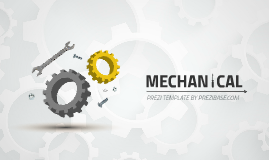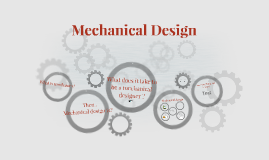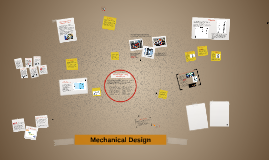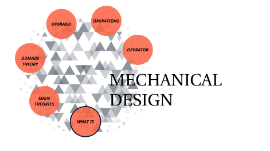Mechanical Design
Transcript: Manufacturing Processes: Forming Manufacturing technologies are economically important because they are the means for adding value to raw materials by converting them into useful products. There are many different manufacturing processes, and each is well suited to a particular need based on environmental impact, dimensional accuracy, material properties, and the mechanical component’s shape. Engineers select those processes, identify the machines and tools, and monitor production to ensure that the final product meets its specifications. The major classes of manufacturing processes are casting, forming, machining, joining, and finishing. Engineer better medicines Reverse-engineer the brain Prevent nuclear terror Secure cyberspace Enhance virtual reality Advance personalized learning Engineer the tools of scientific discovery Product archaeology is the process of reconstructing the lifecycle of a product – the customer requirements, design specifications, and manufacturing processes used to produce it– to understand the decisions that led to its development. 1. Preparation: background research about a product including market research, patent searches, and benchmarking existing products. 2. Excavation: component description, dissection and analysis 3. Evaluation: benchmarking existing products, conduct material and product tests. 4. Explanation: draw conclusions about the issues that shaped the design of the product. Production Focus On: Product Archaeology Utility Patents Guiding principles in this stage are simplicity, iteration, and usability. At this point, many design and manufacturing details remain open, and each one must be resolved in order to produce the hardware for the product. In the detailed design of the product a number of issues must be determined, including: Develop product layout and configuration Select materials for each component Optimize final geometry including appropriate tolerances Develop completed digital models of all components and assemblies Simulate system using digital and mathematical models Prototype and test critical components and modules Develop production plans Another prototyping technique moves a print head to spray a liquid adhesive onto a powder and “glue-up” a prototype bit-by-bit. Curriculum Topics Manufacturing Processes Mechanical engineers will play important roles in each of these 14 challenges over the next few decades, most notably the highlighted ones. ME’s will need to know and use solid design principles to be successful. Patents are granted for a new and useful process, machine, article of manufacture, or composition of matter, or an improvement of them. Some rapid prototyping systems use lasers to fuse layers of a liquid polymer together (a process known as stereolithography) or to fuse raw material in powder form. Design Process Focus On: Global Design Teams Manufacturing Processes: Casting Initially, a design engineer will develop a comprehensive set of system requirements considering the following issues: Functional performance – what the product must accomplish. Environmental impact – during production, use, and retirement. Manufacturing – resource and material limitations. Economic issues – budget, cost, price, profit. Ergonomic concerns – human factors, aesthetics, ease of use. Global issues – international markets, needs, and opportunities. Life-cycle issues – use, maintenance, planned obsolescence. Social factors – civic, urban, cultural issues. Documentation Forming encompasses a family of techniques in which a raw material is shaped by stretching, bending, or compressing it. Large forces are applied to plastically deform a material into its new permanent shape. Rolling is the process of reducing the thickness of a flat sheet of material by compressing it between rollers. Forging is another forming process, and it is based on the principle of heating, impacting, and plastically deforming metal into a final shape. Detailed Design Most commonly encountered in mechanical engineering, the utility patent protects the function of an apparatus, process, product, or composition of matter. Conceptual Design Joining operations are used to assemble subcomponents into a final product by welding, soldering, riveting, bolting, or adhesively bonding them. Many bicycle frames, for instance, are welded together from individual pieces of metal tubing. Finishing steps are taken to treat a component’s surface in order to make it harder, improve its appearance, or protect it from the environment. Some finishing processes include polishing, electroplating, anodizing, and painting. Extrusion is used to create long straight metal parts with their cross sections having round, rectangular, L-, T-, or C-shapes, for instance. In extrusion, a mechanical or hydraulic press is used to force heated metal through a tool (called a die) that has a tapered hole ending in the shape of the finished part’s cross section. Conceptually, the process of extrusion is not unlike the

















